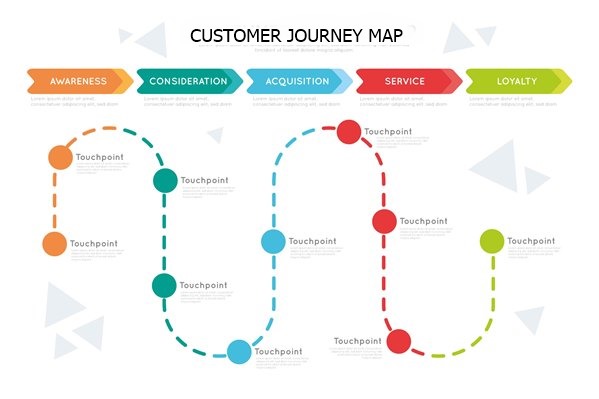
Customer Experience Engineering (CXE) is a growing field that focuses on designing, managing, and improving the interactions between a company and its customers.
At its core, customer experience engineering seeks to ensure that every touchpoint a customer has with a company leaves a positive and lasting impression. This discipline combines aspects of design, psychology, marketing, and technology to create engaging, satisfying, and memorable experiences for consumers.
To excel in customer experience engineering, professionals need to have a deep understanding of customer behavior, preferences, and expectations. They use data gathered from customer interactions to pinpoint areas for optimization, making data-driven decisions that improve various aspects of a customer’s journey – from initial discovery, through purchasing and support, to long-term loyalty and brand advocacy. Moreover, the success of customer experience engineering also relies on dedicated tech team recruitment, as these teams are instrumental in implementing the technological solutions that enhance the overall customer experience.
The role of customer experience engineering in the business world today cannot be underestimated. As competition across industries becomes more fierce, companies that prioritize their customers’ experience stand to gain an advantage in the marketplace. By employing customer experience engineering principles and strategies, organizations can foster stronger relationships with their customers and ultimately drive business growth.

Understanding Customer Experience Engineering
Role of Experience Engineering in Business Growth
Customer Experience Engineering (CXE) is a strategic approach to designing and optimizing the interactions between a business and its customers. It focuses on creating a seamless and delightful experience for customers throughout their journey, including pre-sales, actual purchase, and post-sales support. This approach is crucial as it directly impacts customer retention, brand loyalty, and revenue generation.
By aligning a company’s products, services, and internal processes with customer needs and expectations, CXE helps businesses to stand out in the competitive market. It enables companies to:
- Identify pain points and opportunities to improve their offerings and customer interactions
- Measure and analyze customer feedback to drive continuous improvements in customer satisfaction
- Create a consistent and memorable brand experience that fosters long-term relationships with customers
Difference Between Customer Experience and Customer Service
It’s essential to understand the difference between customer experience (CX) and customer service to implement effective CXE strategies. While both are integral to a company’s success, they differ in scope and focus.
- Customer Experience (CX): CX is a broader concept that encompasses the customer’s perception of their interactions with the entire brand, including the products, services, and various touchpoints. It covers the overall journey from pre-sale research to post-sale support and aims to create a positive and memorable impression.
- Customer Service: Customer service is a subset of CX that focuses on the specific interactions between customers and company representatives. It deals with resolving issues, providing information, and facilitating transactions, but it does not cover the complete customer journey.
As a result, when engineering customer experiences, businesses must address not only customer service touchpoints but also consider the entire customer journey, covering aspects like product offerings, pricing, and communication channels.
By focusing on CXE, businesses can foster customer loyalty, increase customer lifetime value, and ultimately drive sustainable growth.

Fundamental Principles of Customer Experience Engineering
Empathy
Empathy is an essential component of customer experience engineering. It involves understanding and acknowledging the needs, emotions, and preferences of customers. Actively listening to customer feedback is crucial in identifying their pain points and evaluating how products and services can be improved. A company exhibiting empathy for its customers demonstrates genuine concern for their well-being, leading to increased trust and loyalty.
Personalization
Personalization enhances the customer experience by tailoring products, services, or interactions to each customer’s unique preferences and needs. This can be achieved through various methods, such as:
- Analyzing customer data to understand their preferences and past behaviors
- Segmenting customers based on their characteristics, such as demographics or preferences
- Offering product recommendations or customized promotions based on individual interests
By adequately addressing the individual needs of customers, businesses can boost customer satisfaction, encourage repeat business, and build strong customer relationships.
Consistency
Consistency is vital for delivering a cohesive customer experience across multiple touchpoints. This may include:
- Ensuring uniform messaging and branding across channels
- Maintaining a similar tone and style in customer-facing communication
- Aligning product and service quality in physical and digital environments
Creating a consistent experience can help build trust, reinforce a company’s identity, and meet customer expectations.
Proactivity
Proactive customer experience engineering involves anticipating customer needs and addressing them before they become a problem. This can include:
- Identifying potential issues and implementing solutions in advance
- Offering assistance throughout the customer journey via well-timed communication or support
- Providing relevant information or tools to empower customers to solve their issues independently
By being proactive, companies can reduce customer frustration and strengthen the overall experience.
Processes and Technologies in Customer Experience Engineering

Customer Journey Mapping
Customer journey mapping is a crucial process in customer experience engineering. It involves visualizing and understanding the customer’s interactions with the organization across different touchpoints. This helps businesses identify bottlenecks, pain points, and opportunities to enhance customer experience. Key steps in the customer journey mapping process include:
- Defining customer personas
- Identifying touchpoints
- Mapping customer interactions and emotions
- Analyzing findings for improvement opportunities.
AI and Machine Learning Techniques
A well-designed customer journey often relies on a streamlined data extraction process to deliver personalized and timely interactions.
AI and machine learning techniques play a significant role in customer experience engineering. They help analyze vast amounts of data to generate insights and automate various customer-facing tasks. AI can facilitate personalized and timely interactions, leading to improved customer engagement. Some common AI applications in customer experience engineering are:
- Chatbots: for resolving customer queries and offering assistance
- Sentiment analysis: to understand customer emotions and feedback
- Personalization: for tailoring offers and content
CRM and Customer Data Management
Effectively managing customer data is vital in customer experience engineering. CRM (Customer Relationship Management) systems help businesses collect, store, and analyze customer information from different channels. CRM enables better decision-making and organization of resources, ensuring that customer needs are met effectively. Key features and benefits of CRM include:
- Single view of the customer: consolidating customer data from various touchpoints
- Segmentation: categorizing customers based on behavior and preferences
- Automation: streamlining marketing processes and tasks
CRM integration with other technologies, such as AI, can further enhance customer experience by enabling more personalized interactions and proactive issue resolution.

Measuring Customer Experiences
Key Performance Indicators
Measuring customer experiences involves tracking Key Performance Indicators (KPIs). KPIs help businesses understand how well they are meeting customer expectations. Some common KPIs include:
- Average time to resolve customer issues
- First contact resolution rate
- Customer effort score
These metrics provide valuable insights to guide improvements in customer experience engineering.
Customer Satisfaction Scores
Customer Satisfaction (CSAT) scores are essential metrics to gauge customer happiness with a product or service. CSAT scores are typically gathered through surveys, where customers rate their satisfaction on a scale of 1 to 5. Ratings should be monitored and analyzed to identify trends and opportunities for improvement.
Net Promoter Scores
Net Promoter Score (NPS) is another metric to assess customer experiences. NPS measures the likelihood of customers recommending a company’s product or service to others. Customers respond on a scale of 0 to 10. The scores are classified into three groups:
- Promoters (9-10)
- Passives (7-8)
- Detractors (0-6)
The NPS is calculated by subtracting the percentage of detractors from the percentage of promoters. Higher NPS scores indicate positive customer experiences.
Churn and Retention Rates
Customer churn and retention rates provide insights into the longevity of customer relationships. Churn rate is the percentage of customers who end their relationship with a company in a given period, while retention rate is the percentage of customers who remain loyal. Monitoring these metrics helps identify issues and opportunities to enhance customer experiences and encourage long-term relationships.

Customer Experience Skills and Training
Emotional Intelligence
Emotional intelligence plays a crucial role in customer experience engineering. It involves the ability to understand, empathize, and manage emotions effectively while interacting with customers. Professionals with higher emotional intelligence can better adapt to different customer personalities, handle difficult situations, and ensure a positive experience for customers.
Communication Skills
Effective communication skills are vital for customer experience engineering. These skills include active listening, clear verbal and written communication, and appropriate non-verbal cues. Professionals need to understand customer needs, convey information concisely, and provide appropriate solutions.
| Skills | Importance |
|---|---|
| Active Listening | Understand customer perspective and requirements |
| Verbal Communication | Clearly convey information and solutions to customers |
| Written Communication | Craft professional and effective emails and documentation |
| Non-Verbal Cues | Adapt body language and tone to match customer situations |
Customer-centric Mindset
Developing a customer-centric mindset is essential for customer experience professionals. This involves prioritizing customer needs and preferences. By focusing on providing value to customers, companies can foster long-term relationships, improve customer satisfaction, and drive business growth.
- Put customer needs first
- Personalize customer interactions
- Maintain a proactive approach
Continuous Learning and Improvement
Continuous learning and improvement involves acquiring new skills, staying updated with industry best practices, and regularly evaluating performance. This helps customer experience professionals adapt to evolving customer demands and remain proficient in their roles.
Incorporate the following aspects for continuous learning and improvement:
- Regular training sessions
- Performance evaluations
- Encouraging feedback culture
- Implementing new techniques and technologies
Customer experience skills and training are essential to engineer high-quality experiences for customers. By fostering emotional intelligence, improving communication skills, maintaining a customer-centric mindset, and focusing on continuous learning and improvement, professionals can excel in this field and drive customer satisfaction.
Industry Applications and Real-Life Examples
Hospitality Industry
Customer experience engineering has been widely applied in the hospitality industry. Hotels, for example, have improved their check-in and check-out processes using technology and personalization. Implementing mobile apps and using guest data have allowed hotels to provide tailored experiences that increase customer satisfaction levels.
Additionally, airlines have utilized advanced seat reservation systems, offering passengers personalized experiences, such as premium meal options and an entertainment system. The goal is to craft unique and memorable experiences for each customer, ultimately leaving them with a positive impression of the brand.
Digital World and Mobile App Experiences
In the digital world, customer experience engineering plays a crucial role in website and mobile app development. Companies invest in intuitive interfaces, personalized recommendations, and responsive customer service features, ensuring that online platforms meet user expectations.
For instance, e-commerce platforms utilize machine learning algorithms for personalized product suggestions and dynamic pricing strategies. Similarly, streaming services analyze user preferences to curate content recommendations, creating a bespoke user experience.
COVID-19 Pandemic Impact on Customer Experiences
The COVID-19 pandemic has presented new challenges for companies in delivering exceptional customer experiences. With social distancing measures and contactless services becoming the norm, businesses have had to adapt to this changing landscape.
- Remote collaboration and support: Companies implemented tools such as live chat, video conferencing, and chatbots to facilitate remote communication and collaboration.
- Contactless services: Delivery and transportation businesses, for example, adopted contactless pick-up and drop-off options.
- Virtual events and experiences: Several sectors, including the arts, fitness, and education, transitioned to virtual formats, leveraging digital platforms to continue interacting with their customers.
In conclusion, customer experience engineering is a vital component for businesses looking to provide high-quality experiences and build strong relationships with customers. Companies must prioritize customer needs and maintain a proactive approach to foster long-term relationships. Additionally, continuous learning and improvement are key to staying ahead in the ever-evolving digital landscape. With the right tools, techniques, and technologies, businesses can engineer meaningful customer experiences that meet customer demands.




